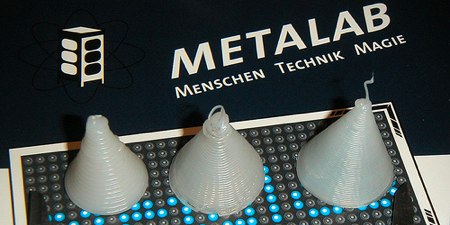
Today at The Last HOPE, [Far McKon] from Philadelphia’s Hacktory presented on community fabrication. Over the last few years we’ve seen a lot of different accessible rapid prototyping machines created. There’s the RepRap, a fabrication machine that has achieved self replication; our friends at Metalab have gotten their own version of the machine running too. The Hacktory has recently acquired a Fab@home machine. Fab@home hopes to make manufacturing using multiple materials accessible to home users. Multiple materials means people have constructed objects that vary from embedded circuits to hors d’oeuvres. We can’t talk about edible prototyping without bringing up the CandyFab machine, which fuses sugar. The Hacktory has enjoyed their machine so far, but have found the learning curve fairly difficult. While it’s great to see the cost of rapid prototyping dropping, we’ll be much happier when the ease of use improves.
4 thoughts on “HOPE 2008: Community Fabrication”
Leave a Reply
Please be kind and respectful to help make the comments section excellent. (Comment Policy)
















btw the image text translates as “Metalab: People, Technology, Magic”, which I think is hilarious.
I’d settle for an easy way to fab high quality PCBs at home. The etching and drilling by hand method is slow, messy and hard to produce very detailed PCBs with. If only there were an affordable machine to do it, or even just an affordable low-volume manufacturer in the UK. Hong Kong fabs it is I guess…
Knitting machines and cocktail robots are two other fabrication devices that aren’t precisely the same as repraps but do possess similar attributes.
I too have found a lot of inspiration from the currently-existing hobbyist fabricators, but they seem like the wrong direction to go for home rapid prototyping. Why isn’t there a large community project to design a retrofit system for off-the-shelf inkjet printers? Using an Arduino to interpret motor-control signals meant for the pagefeed motor and using that to drive a stepper powerful enough to shift the entire print-arm assembly up and down a flat field should be pretty easy. More work would be needed to convert this flatbed printer to a true rapid prototyper, but the basic idea is there. RepRap, Fab@Home, and Candyfab are all brilliant projects, but the items they produce are all terrible from a user standpoint, with an effective mm^3 resolution, there are very few attractive or complicated objects that can be made that couldn’t be made better at a roughly .127 mm^3 resolution.